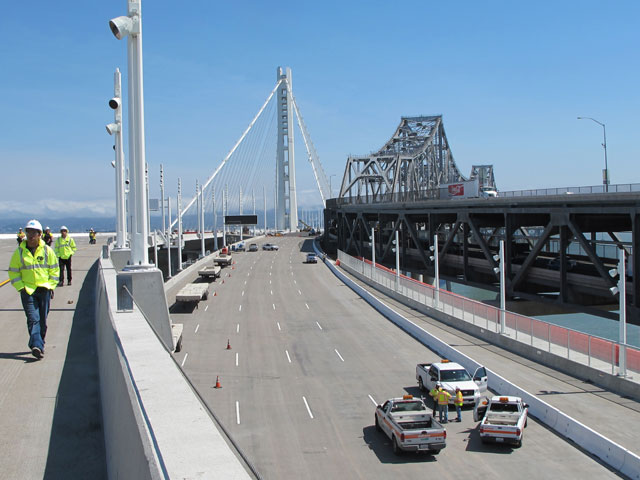Why were they exposed? Because, in many cases, protective grouting was incomplete or missing. Here's how the Chronicle describes the situation:
Caltrans resident engineer Bill Casey said crews had found water on 95 percent of the rods at the base of the tower, in most cases “1 or 2 inches” deep in pockets between grout that surrounds the rods in their sleeves and caulk caps intended to keep the sleeves dry.
However, 17 rods were not properly filled with grout, including one that had only a foot of the protective material in the 15-foot sleeve, Casey said. Those rods were stewing in several gallons of water. ...
... The rods were installed by Kiewit Construction, which had the fabrication contract for the 525-foot-tall tower foundation. They were put in place before the structure was added beginning in 2010.
Brian Maroney, the chief Caltrans engineer on the project, said the caulking may have failed when the rods at the tower base were tightened.
In their presentations Tuesday, engineers said steps are being taken to make sure the rods at the tower base are properly protected to prevent further corrosion. And they said that they don't believe the rods at the tower base are subject to snapping the way those in the seismic structure did last year. That's because even though both sets of rods apparently experienced long-term exposure to water, the tower rods are not under the same high tension that led the seismic rods to become brittle and break.
And that leads us back to Twist 2 in our story.
Maroney presented a 187-page report on an intensive testing and inspection program for all the 2,000-plus rods and bolts on the bridge that are made of the same kind of steel that failed in the eastern span's seismic structure. The verdict: The rest of the rods in the bridge appear to be in good shape and show no evidence of the kind of embrittlement that led the seismic steel to snap.
"To me one of the overwhelming lessons of this whole episode is that we should have been doing some sort of testing before we put these rods on the bridge, not after we installed them. We've been playing catch-up ever since," said Steve Heminger, executive director of the Metropolitan Transportation Commission and head of the toll bridge oversight panel.
Heminger has remained steadfastly upbeat as one problem after another has emerged in the new span's construction. The issues include the project's massive cost overruns -- it has cost about $6.5 billion, several times the original price tag -- questions about the quality of concrete used in bridge foundation, the discovery of water invading steel tendons that support the bridge's skyway structure, the discovery of water in structural supports in the suspension span, questions about the soundness of welding on sections of the bridge deck and allegations that Caltrans has mismanaged the project.
Tuesday, it sounded like Heminger's had enough bad news. "I am a problem-solver," the Chron quotes him as saying about the new disclosures about the tower rods. "This is another problem — I certainly wish we would stop finding problems to solve."
Sen. Mark DeSaulnier, D-Concord, is chairman of the state Senate Transportation and Housing Committee, which has been investigating the Bay Bridge construction problems. He said Tuesday that although he believes the new span is safe, he's concerned about what the future holds.
"How safe, and how much is it going to cost us to keep it safe, I think is a whole different discussion," he said. "And it's my belief that unfortunately for people who commute over that bridge, people who pay the toll, they're going to be reading about these kinds of things for years to come."
